Calpastatin-Mediated Inhibition of Calpain Ameliorates Skin Scar Formation after Burn Injury
Abstract
1. Introduction
2. Results
2.1. Calpain Activity and Expression Are Increased in Burn-Wound Fibroblasts (BFs) Obtained from Patients
2.2. Fibrotic Marker Expression Is Increased at Both Transcriptional and Translational Levels in Patient BFs
2.3. Calpastatin Inhibits In Vitro Proliferation of Patient BFs
2.4. Calpastatin Inhibits Calpain Activity and Expression in Patient BFs
2.5. Calpastatin Inhibits Fibrotic Marker Expression in Patient BFs
2.6. Calpastatin Suppresses Fibrotic Marker Expression in Mouse Burn-Wound Tissues
2.7. Calpastatin Inhibits Post-Burn Scar Formation in Mice
3. Discussion
4. Materials and Methods
4.1. Human Specimens
4.2. Animals Used
4.3. Fibroblast Isolation and Culture
4.4. Cell Proliferation and Calpastatin Treatment
4.5. Determination of Calpain Activity
4.6. Murine Burn Models and Calpastatin Treatment
4.7. The qRT-PCR Analysis
4.8. Western Blot Analysis
4.9. Histological Evaluation
4.10. Statistical Analyses
Supplementary Materials
Author Contributions
Funding
Institutional Review Board Statement
Informed Consent Statement
Data Availability Statement
Acknowledgments
Conflicts of Interest
References
- Gauglitz, G.G.; Korting, H.C.; Pavicic, T.; Ruzicka, T.; Jeschke, M.G. Hypertrophic scarring and keloids: Pathomechanisms and current and emerging treatment strategies. Mol. Med. 2011, 17, 113–125. [Google Scholar] [CrossRef] [PubMed]
- Lawrence, J.W.; Mason, S.T.; Schomer, K.; Klein, M.B. Epidemiology and impact of scarring after burn injury: A systematic review of the literature. J. Burn Care Res. 2012, 33, 136–146. [Google Scholar] [CrossRef] [PubMed]
- Finnerty, C.C.; Jeschke, M.G.; Branski, L.K.; Barret, J.P.; Dziewulski, P.; Herndon, D.N. Hypertrophic scarring: The greatest unmet challenge after burn injury. Lancet 2016, 388, 1427–1436. [Google Scholar] [PubMed]
- Darby, I.A.; Laverdet, B.; Bonté, F.; Desmoulière, A. Fibroblasts and myofibroblasts in wound healing. Clin. Cosmet. Investig. Dermatol. 2014, 7, 301–311. [Google Scholar] [PubMed]
- Wang, J.; Ding, J.; Jiao, H.; Honardoust, D.; Momtazi, M.; Shankowsky, H.; Tredget, E.E. Human hypertrophic scar-like nude mouse model: Characterization of the molecular and cellular biology of the scar process. Wound Repair Regen. 2011, 19, 274–285. [Google Scholar] [CrossRef]
- Momeni, H.R. Role of calpain in apoptosis. Cell J. 2011, 13, 65–72. [Google Scholar]
- Glading, A.; Lauffenburger, D.A.; Wells, A. Cutting to the chase: Calpain proteases in cell motility. Trends Cell Biol. 2002, 12, 46–54. [Google Scholar] [CrossRef]
- Jánossy, J.; Ubezio, P.; Apáti, A.; Magócsi, M.; Tompa, P.; Friedrich, P. Calpain as a multi-site regulator of cell cycle. Biochem. Pharmacol. 2004, 67, 1513–1521. [Google Scholar] [CrossRef]
- Goll, D.E.; Thompson, V.F.; Li, H.; Wei, W.; Cong, J. The calpain system. Physiol. Rev. 2003, 83, 731–801. [Google Scholar] [CrossRef]
- Tabata, C.; Tabata, R.; Nakano, T. The calpain inhibitor calpeptin prevents bleomycin-induced pulmonary fibrosis in mice. Clin. Exp. Immunol. 2010, 162, 560–567. [Google Scholar] [CrossRef]
- Li, F.Z.; Cai, P.C.; Song, L.J.; Zhou, L.L.; Zhang, Q.; Rao, S.S.; Xia, Y.; Xiang, F.; Xin, J.B.; Greer, P.A.; et al. Crosstalk between calpain activation and TGF-β1 augments collagen-I synthesis in pulmonary fibrosis. Biochim. Biophys. Acta 2015, 1852, 1796–1804. [Google Scholar] [CrossRef] [PubMed]
- Letavernier, E.; Zafrani, L.; Perez, J.; Letavernier, B.; Haymann, J.P.; Baud, L. The role of calpains in myocardial remodelling and heart failure. Cardiovasc. Res. 2012, 96, 38–45. [Google Scholar] [CrossRef]
- Tang, L.; Pei, H.; Yang, Y.; Wang, X.; Wang, T.; Gao, E.; Li, D.; Yang, Y.; Yang, D. The inhibition of calpains ameliorates vascular restenosis through MMP2/TGF-β1 pathway. Sci. Rep. 2016, 6, 29975. [Google Scholar] [CrossRef] [PubMed]
- Tan, W.J.; Tan, Q.Y.; Wang, T.; Lian, M.; Zhang, L.; Cheng, Z.S. Calpain 1 regulates TGF-β1-induced epithelial-mesenchymal transition in human lung epithelial cells via PI3K/Akt signaling pathway. Am. J. Transl. Res. 2017, 9, 1402–1409. [Google Scholar] [PubMed]
- Eto, A.; Akita, Y.; Saido, T.C.; Suzuki, K.; Kawashima, S. The role of the calpain-calpastatin system in thyrotropin-releasing hormone-induced selective down-regulation of a protein kinase c isozyme, npkc epsilon, in rat pituitary gh4c1 cells. J. Biol. Chem. 1995, 270, 25115–25120. [Google Scholar] [CrossRef] [PubMed]
- Maki, M.; Bagci, H.; Hamaguchi, K.; Ueda, M.; Murachi, T.; Hatanaka, M. Inhibition of calpain by a synthetic oligopeptide corresponding to an exon of the human calpastatin gene. J. Biol. Chem. 1989, 264, 18866–18869. [Google Scholar] [CrossRef]
- Letavernier, E.; Perez, J.; Bellocq, A.; Mesnard, L.; de Castro Keller, A.; Haymann, J.P.; Baud, L. Targeting the calpain/calpastatin system as a new strategy to prevent cardiovascular remodeling in angiotensin II-induced hypertension. Circ. Res. 2008, 102, 720–728. [Google Scholar] [CrossRef]
- Li, Y.; Ma, J.; Zhu, H.; Singh, M.; Hill, D.; Greer, P.A.; Arnold, J.M.; Abel, E.D.; Peng, T. Targeted inhibition of calpain reduces myocardial hypertrophy and fibrosis in mouse models of type 1 diabetes. Diabetes 2011, 60, 2985–2994. [Google Scholar] [CrossRef]
- Li, X.; Li, Y.; Shan, L.; Shen, E.; Chen, R.; Peng, T. Over-expression of calpastatin inhibits calpain activation and attenuates myocardial dysfunction during endotoxaemia. Cardiovasc. Res. 2009, 83, 72–79. [Google Scholar] [CrossRef]
- Fukui, I.; Tanaka, K.; Murachi, T. Extracellular appearance of calpain and calpastatin in the synovial fluid of the knee joint. Biochem. Bioph. Res. Commun. 1989, 162, 559–566. [Google Scholar] [CrossRef]
- Wan, F.; Letavernier, E.; Abid, S.; Houssaini, A.; Czibik, G.; Marcos, E.; Rideau, D.; Parpaleix, A.; Lipskaia, L.; Amsellem, V.; et al. Extracellular calpain/calpastatin balance is involved in the progression of pulmonary hypertension. Am. J. Resp. Cell Mol. Biol. 2016, 55, 337–351. [Google Scholar] [CrossRef]
- Chiang, R.S.; Borovikova, A.A.; King, K.; Banyard, D.A.; Lalezari, S.; Toranto, J.D.; Paydar, K.Z.; Wirth, G.A.; Evans, G.R.; Widgerow, A.D. Current concepts related to hypertrophic scarring in burn injuries. Wound Repair Regen. 2016, 24, 466–477. [Google Scholar] [CrossRef] [PubMed]
- Roth, M.; Eickelberg, O.; Kohler, E.; Erne, P.; Block, L.H. Ca2+ channel blockers modulate metabolism of collagens within the extracellular matrix. Proc. Natl. Acad. Sci. USA 1996, 93, 5478–5482. [Google Scholar] [CrossRef]
- Liu, Y.; Liu, B.; Zhang, G.Q.; Zou, J.F.; Zou, M.L.; Cheng, Z.S. Calpain inhibition attenuates bleomycin-induced pulmonary fibrosis via switching the development of epithelial-mesenchymal transition. Naunyn-Schmiedeberg’s Arch. Pharmacol. 2018, 391, 695–704. [Google Scholar] [CrossRef] [PubMed]
- Cui, H.S.; Hong, A.R.; Kim, J.B.; Yu, J.H.; Cho, Y.S.; Joo, S.Y.; Seo, C.H. Extracorporeal shock wave therapy alters the expression of fibrosis-related molecules in fibroblast derived from human hypertrophic scar. Int. J. Mol. Sci. 2018, 19, 124. [Google Scholar] [CrossRef]
- Cubison, T.C.; Pape, S.A.; Parkhouse, N. Evidence for the link between healing time and the development of hypertrophic scars (HTS) in paediatric burns due to scald injury. Burns 2006, 32, 992–999. [Google Scholar] [CrossRef]
- Lin, X.Y.; Chen, S.Z. Calpain inhibitors ameliorate muscle wasting in a cachectic mouse model bearing ct26 colorectal adenocarcinoma. Oncol. Rep. 2017, 37, 1601–1610. [Google Scholar] [CrossRef] [PubMed]
- Livak, K.J.; Schmittgen, T.D. Analysis of relative gene expression data using real-time quantitative PCR and the 2(-Delta C (T)) method. Methods 2001, 25, 402–408. [Google Scholar] [CrossRef]
- Kim, S.J.; Lee, Y.J.; Kim, J.B. Reduced expression and abnormal localization of the K (ATP) channel subunit SUR2A in patients with familial hypokalemic periodic paralysis. Biochem. Biophys. Res. Commun. 2010, 391, 974–978. [Google Scholar] [CrossRef]
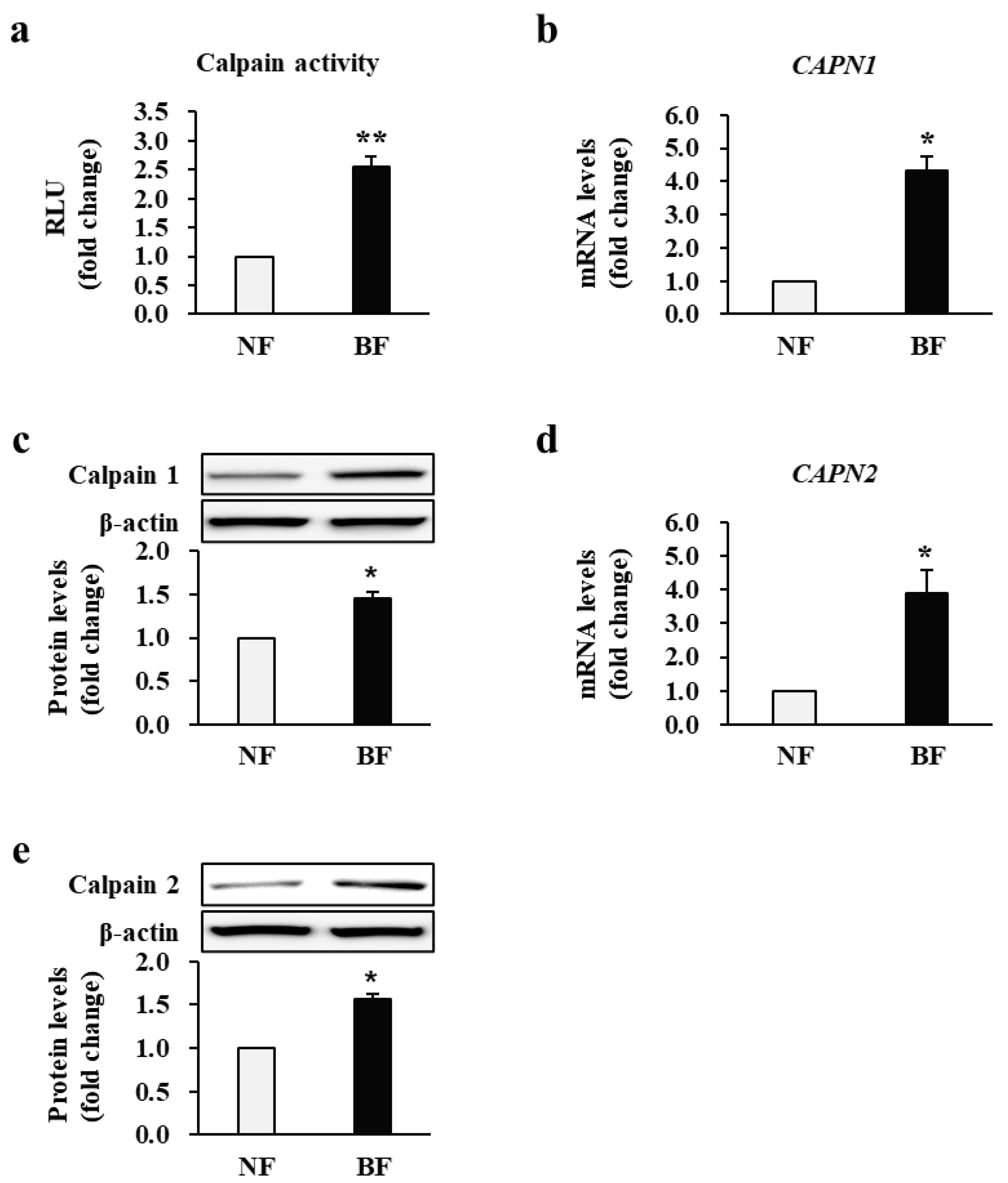

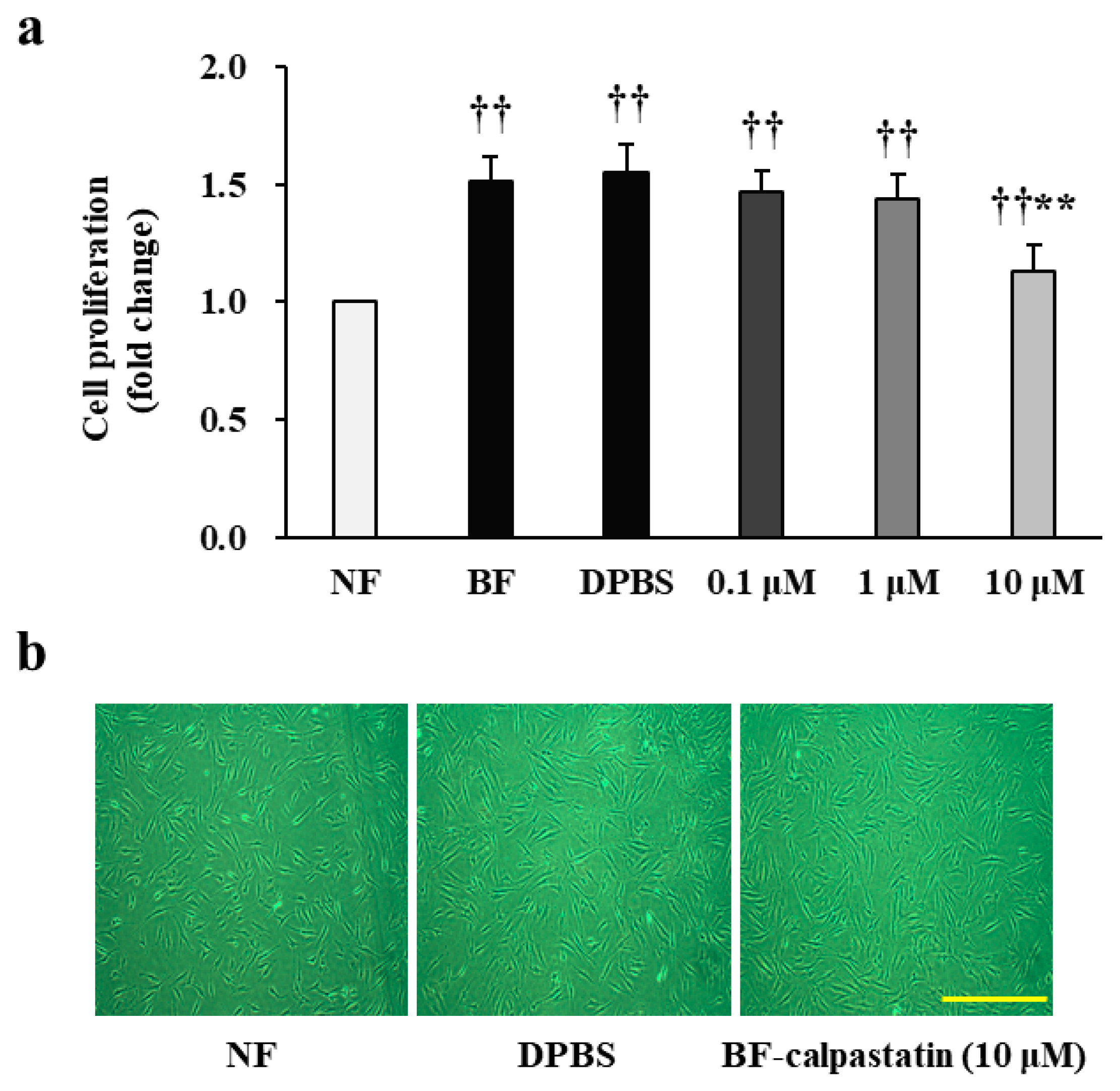
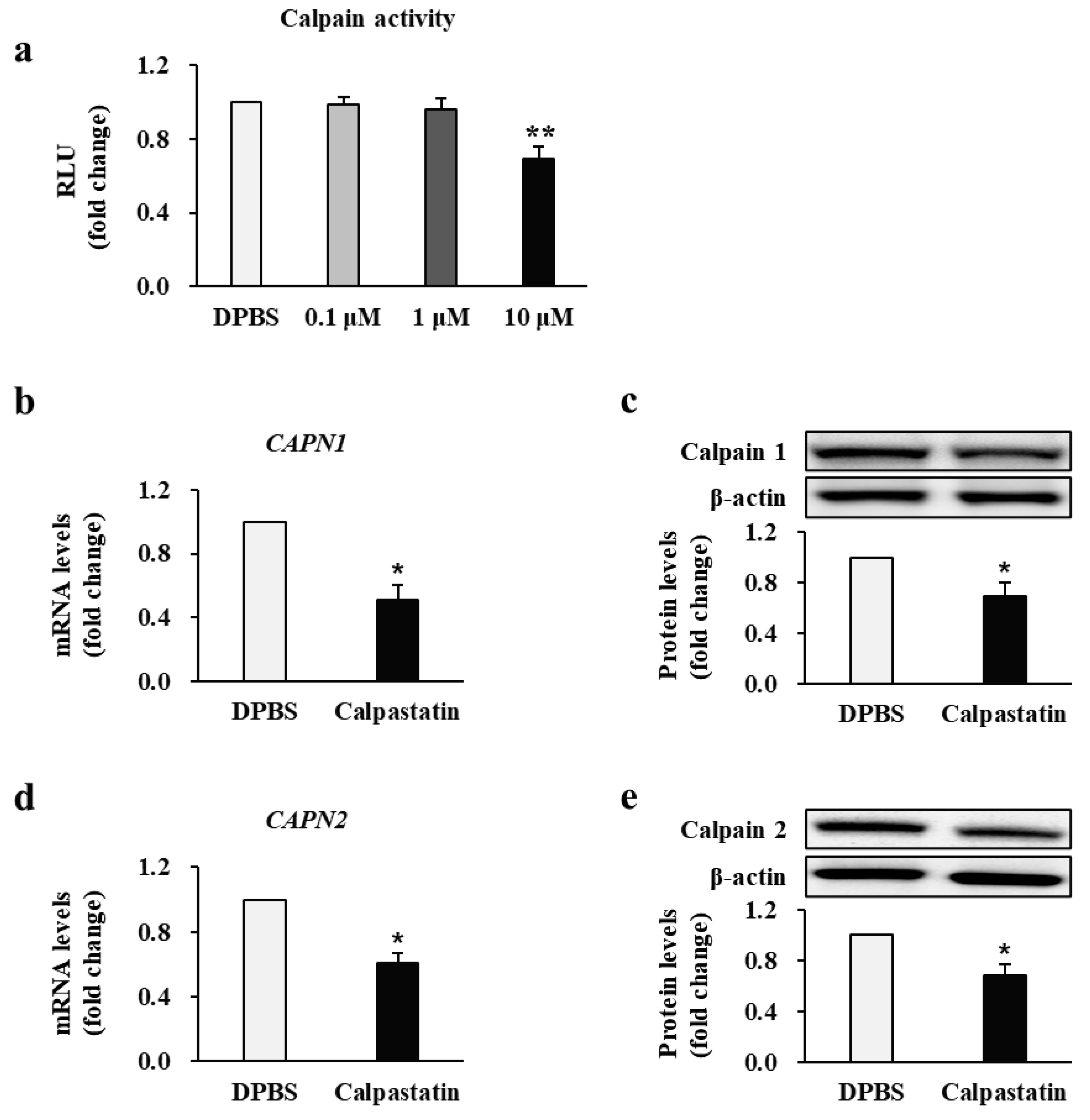
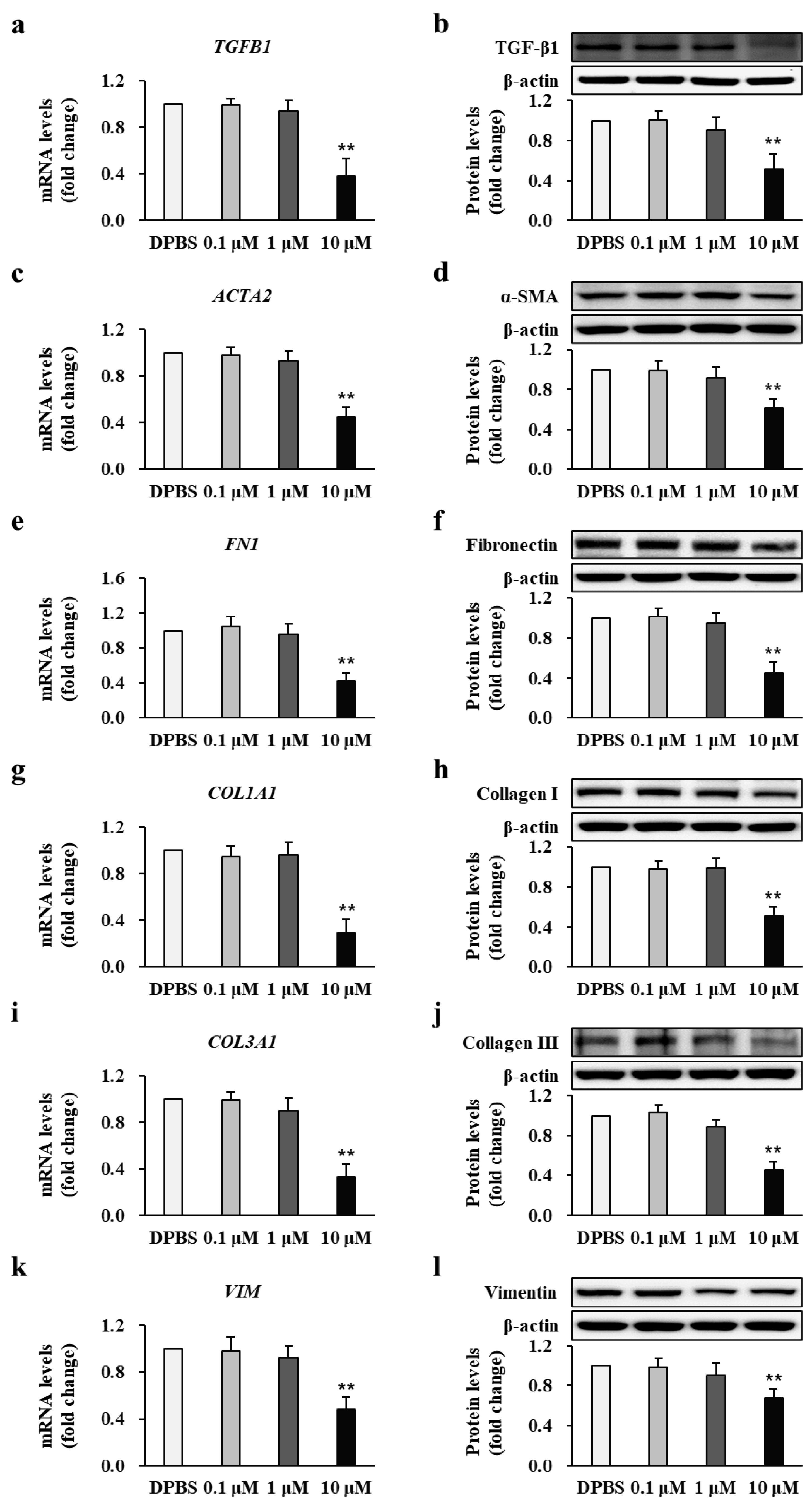

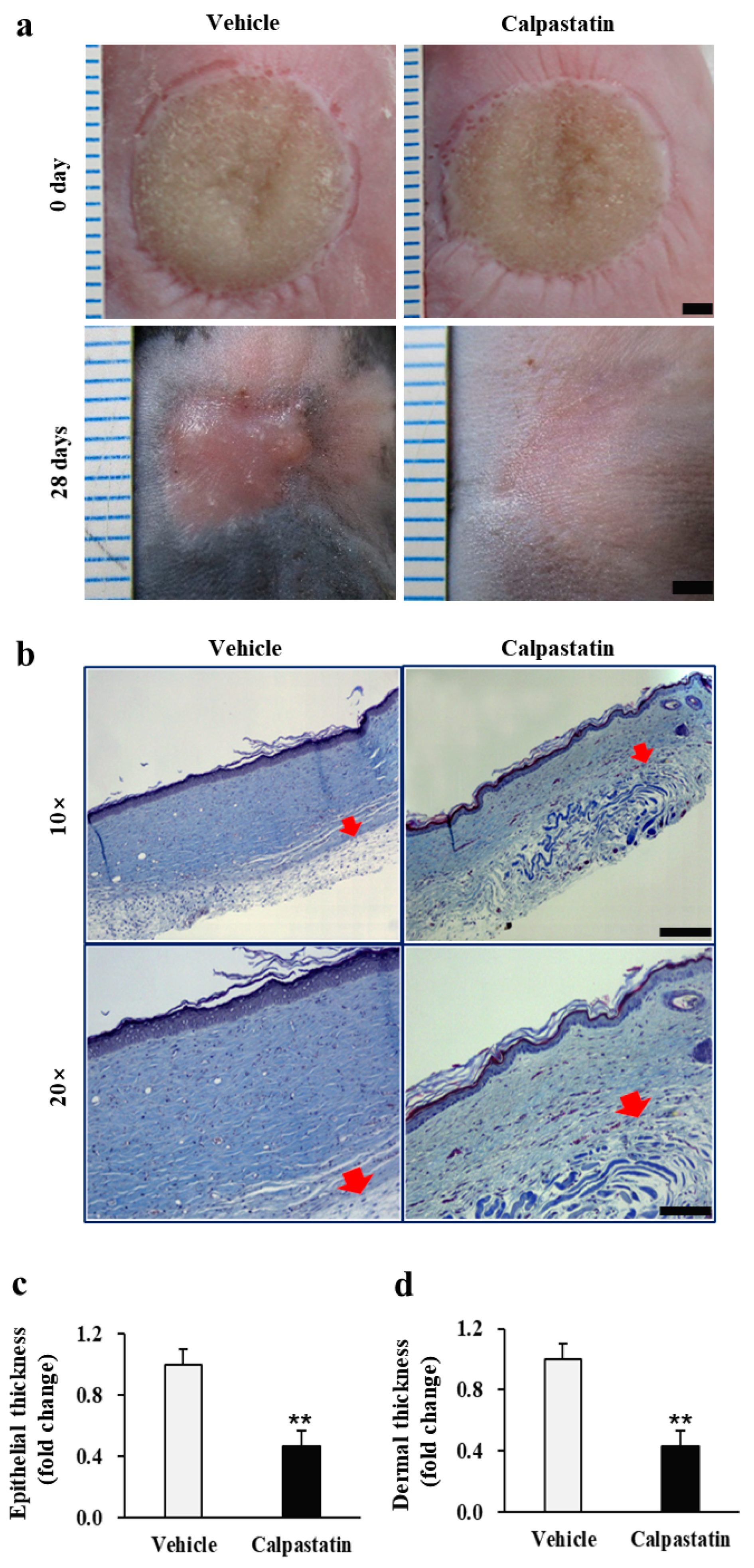
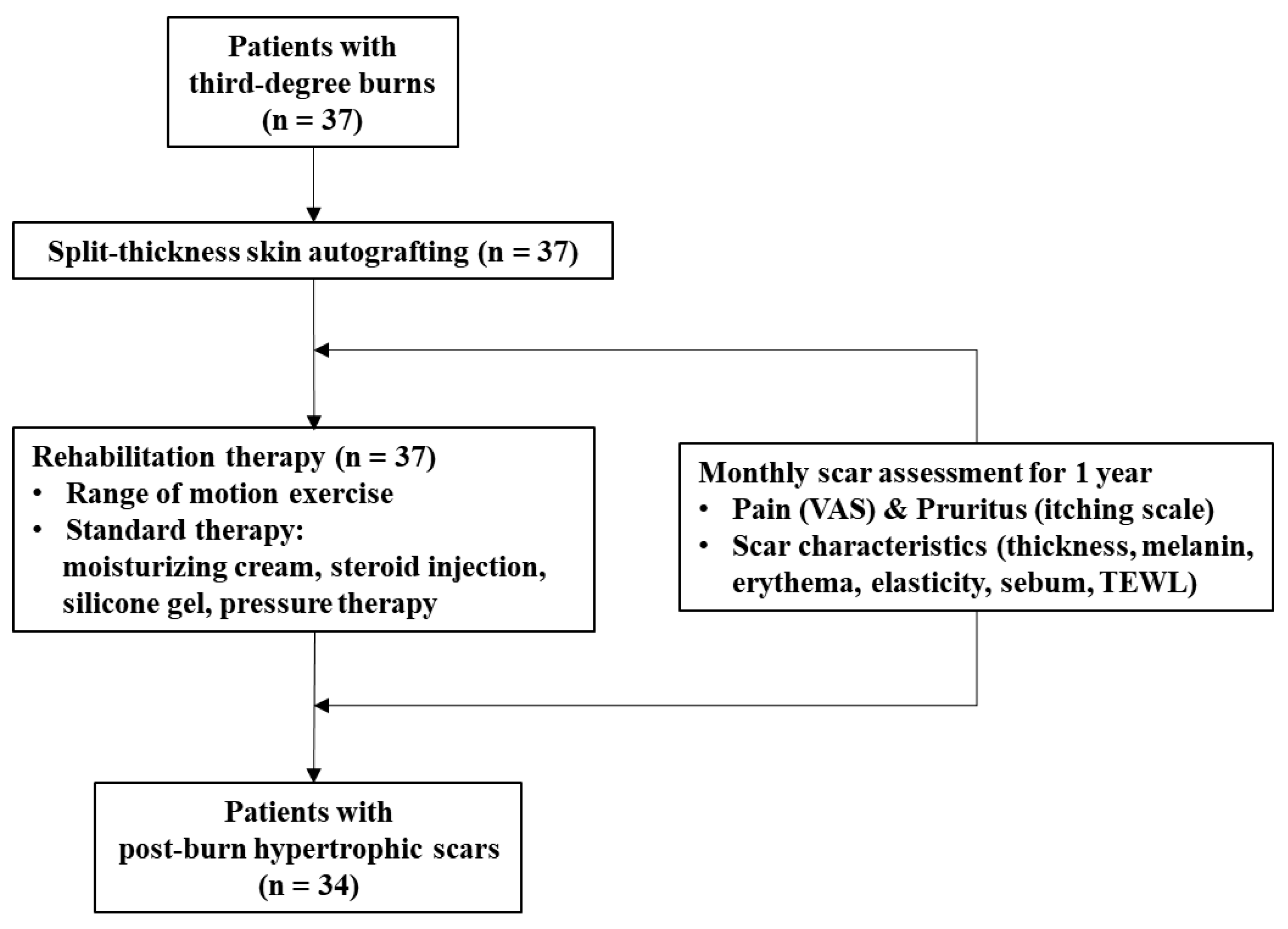
| Patients (n = 34) | Cause | Age (Years) | Gender | % TBSA Burned | Location of Specimens (Burn/Non-Burn) |
|---|---|---|---|---|---|
| 1 | Scald | 53 | Male | 23 | Leg/leg |
| 2 | Scald | 28 | Male | 27 | Thigh/thigh |
| 3 | Flame | 31 | Male | 28 | Leg/leg |
| 4 | Flame | 25 | Male | 22.5 | Hand/hand |
| 5 | Flame | 21 | Male | 23.5 | Abdomen/abdomen |
| 6 | Contact | 43 | Male | 27 | Arm/arm |
| 7 | Contact | 25 | Male | 23 | Hand/hand |
| 8 | Electrical | 36 | Male | 23 | Hand/hand |
| 9 | Scald | 48 | Male | 22.5 | Face/scalp |
| 10 | Flame | 8 | Male | 27 | Shoulder/shoulder |
| 11 | Contact | 15 | Male | 28 | Hand/hand |
| 12 | Contact | 24 | Male | 27 | Leg/leg |
| 13 | Flame | 38 | Male | 23.5 | Back/back |
| 14 | Flame | 56 | Male | 27 | Abdomen/abdomen |
| 15 | Contact | 31 | Male | 27 | Chest/abdomen |
| 16 | Flame | 42 | Male | 22.5 | Thigh/thigh |
| 17 | Contact | 18 | Male | 23 | Hand/hand |
| 18 | Flame | 49 | Male | 23 | Leg/leg |
| 19 | Flame | 26 | Male | 22.5 | Thigh/thigh |
| 20 | Flame | 41 | Male | 27 | Face/scalp |
| 21 | Flame | 26 | Male | 23 | Abdomen/abdomen |
| 22 | Scald | 24 | Female | 28 | Leg/leg |
| 23 | Contact | 33 | Female | 22.5 | Thigh/thigh |
| 24 | Flame | 61 | Female | 27 | Face/scalp |
| 25 | Flame | 25 | Female | 28 | Abdomen/back |
| 26 | Flame | 34 | Female | 23.5 | Breast/abdomen |
| 27 | Flame | 59 | Female | 23 | Face/scalp |
| 28 | Flame | 37 | Female | 22.5 | Abdomen/thigh |
| 29 | Contact | 12 | Female | 27 | Leg/leg |
| 30 | Flame | 35 | Female | 23 | Arm/arm |
| 31 | Scald | 57 | Female | 23 | Thigh/thigh |
| 32 | Flame | 19 | Female | 22.5 | Breast/abdomen |
| 33 | Flame | 43 | Female | 27 | Leg/leg |
| 34 | Scald | 31 | Female | 28 | Thigh/thigh |
| Gene | Forward (5′ → 3′) | Reverse (5′ → 3′) | Efficiency (%) |
|---|---|---|---|
| TGFB1 (h) | GTTAAAAGTGGAGCAGCACG | GAGGTATCGCCAGGAATTGT | 99.5 |
| ACTA2 (h) | CCGACCGAATGCAGAAGGA | ACAGAGTATTTGCGCTCCGAA | 101.3 |
| FN1 (h) | CCAGTCCACAGCTATTCCTG | ACAACCACGGATGAGCTG | 100.2 |
| COL1A1 (h) | ATGTTCAGCTTTGTGGACCTC | CTGTACGCAGGTGATTGGTG | 99.8 |
| COL3A1 (h) | CACTGGGGAATGGAGCAAAAC | ATCAGGACCACCAATGTCATAGG | 103.1 |
| VIM (h) | AACCGACACTCCTACAAGAT | CAGAAACAAGTTGGTTGGATAC | 99.9 |
| CAPN1 (h) | CCTCCCTCACTCTCAACGAC | CTCCAGAACTCGTTGCCTTC | 100.3 |
| CAPN2 (h) | CTGTAGCTAACTGGCCCATCC | TGGAAATTCGTTCCTTTGCG | 101.5 |
| CAST (h) | AAAGCGAAGGATTCAGCAAA | TCAAAAGTCACCATCCACCA | 100.2 |
| GAPDH (h) | CATGAGAAGTATGACAACAGCCT | AGTCCTTCCACGATACCAAAGT | 101.2 |
| Tgfb1 (m) | CACTCCCGTGGCTTCTAGTG | GTCTTGCAGGTGGAGAGTCC | 99.3 |
| Acta2 (m) | CAGATGTGGATCAGCAAACAGGA | GACTTAGAAGCATTTGCGGTGGA | 99.8 |
| Fn1 (m) | ATCATAGTGGAGGCACTGCAGAA | GGTCAAAGCATGAGTCATCTGTAGG | 102.1 |
| Col1a1 (m) | GACATGTTCAGCTTTGTGGACCTC | GGGACCCTTAGGCCATTGTGTA | 100.5 |
| Col3a1 (m) | GCACAGCAGTCCAACGTAGA | TCTCCAAATGGGATCTCTGG | 101.8 |
| Vim (m) | AAAGCGTGGCTGCCAAGAA | ACCTGTCTCCGGTACTCGTTTGA | 103.4 |
| Gapdh (m) | CATGGCCTTCCGTGTTCCTA | TGTCATCATACTTGGCAGGTTTCT | 103.2 |
Publisher’s Note: MDPI stays neutral with regard to jurisdictional claims in published maps and institutional affiliations. |
© 2021 by the authors. Licensee MDPI, Basel, Switzerland. This article is an open access article distributed under the terms and conditions of the Creative Commons Attribution (CC BY) license (https://creativecommons.org/licenses/by/4.0/).
Share and Cite
Seo, C.H.; Cui, H.S.; Kim, J.-B. Calpastatin-Mediated Inhibition of Calpain Ameliorates Skin Scar Formation after Burn Injury. Int. J. Mol. Sci. 2021, 22, 5771. https://doi.org/10.3390/ijms22115771
Seo CH, Cui HS, Kim J-B. Calpastatin-Mediated Inhibition of Calpain Ameliorates Skin Scar Formation after Burn Injury. International Journal of Molecular Sciences. 2021; 22(11):5771. https://doi.org/10.3390/ijms22115771
Chicago/Turabian StyleSeo, Cheong Hoon, Hui Song Cui, and June-Bum Kim. 2021. "Calpastatin-Mediated Inhibition of Calpain Ameliorates Skin Scar Formation after Burn Injury" International Journal of Molecular Sciences 22, no. 11: 5771. https://doi.org/10.3390/ijms22115771
APA StyleSeo, C. H., Cui, H. S., & Kim, J.-B. (2021). Calpastatin-Mediated Inhibition of Calpain Ameliorates Skin Scar Formation after Burn Injury. International Journal of Molecular Sciences, 22(11), 5771. https://doi.org/10.3390/ijms22115771





